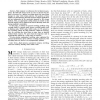Free Online Productivity Tools
i2Speak
i2Symbol
i2OCR
iTex2Img
iWeb2Print
iWeb2Shot
i2Type
iPdf2Split
iPdf2Merge
i2Bopomofo
i2Arabic
i2Style
i2Image
i2PDF
iLatex2Rtf
Sci2ools
CORR
2010
Springer
2010
Springer
Trajectory Codes for Flash Memory
Abstract--Flash memory is well-known for its inherent asymmetry: the flash-cell charge levels are easy to increase but are hard to decrease. In a general rewriting model, the stored data changes its value with certain patterns. The patterns of data updates are determined by the data structure and the application, and are independent of the constraints imposed by the storage medium. Thus, an appropriate coding scheme is needed so that the data changes can be updated and stored efficiently under the storage-medium's constraints. In this paper, we define the general rewriting problem using a graph model. It extends many known rewriting models such as floating codes, WOM codes, buffer codes, etc. We present a new rewriting scheme for flash memories, called the trajectory code, for rewriting the stored data as many times as possible without block erasures. We prove that the trajectory code is asymptotically optimal in a wide range of scenarios. We also present randomized rewriting code...
Arbitrary Rewriting Sequences | CORR 2010 | Education | General Rewriting | General Rewriting Model |
| Added | 01 Mar 2011 |
| Updated | 01 Mar 2011 |
| Type | Journal |
| Year | 2010 |
| Where | CORR |
| Authors | Anxiao Jiang, Michael Langberg, Moshe Schwartz, Jehoshua Bruck |
Comments (0)

